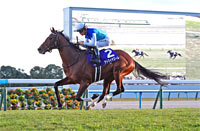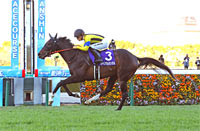Asahi Hai Futurity Stakes (G1) - Data Analysis
2-year-old champion decider that has implications for major races in following year
Among the runners that entered the Asahi Hai Futurity Stakes from 2017 to 2019, a total of six secured a victory in a JRA G1 race in the following year (as of end-November 2020). These runners included fourth-place finisher Keiai Nautique in 2017 and eight-place finisher Lauda Sion in 2019, who both notched wins in the NHK Mile Cup of following next year. In other words, it is not uncommon for horses that were defeated in the Asahi Hai Futurity Stakes to subsequently triumph in major races. Let’s now analyze some features shared by successful runners in this race based on results over the last 10 years, including 2013 and previous years, when the Asahi Hai Futurity Stakes was held as a 1,600m turf race at Nakayama Racecourse.
Stable record a key point to watch
Of the 30 Top 3 finishers over the last 10 years, 27 had no experience of being beaten to 5th or lower in races other than “1,800m+ graded races.” Conversely, runners with such experience struggled with a Top 3 ratio of 4.7%. This suggests we should expect little from runners with experience of being beaten to 5th or lower in races other than 1,800m+ graded races (Sapporo Nisai Stakes, Tokyo Sports Hai Nisai Stakes, Kyoto Nisai Stakes). [Table 1]
[Table 1] Experience of being beaten to 5th or lower in races other than “1,800m+ graded races” (last 10 years)
| Experience |
Performance
[1st-2nd-3rd-4th or lower] |
Win ratio |
Top 2 ratio |
Top 3 ratio |
| Yes |
1-0-2-61 |
1.6% |
1.6% |
4.7% |
| No |
9-10-8-72 |
9.1% |
19.2% |
27.3% |
Check record from late September onward
Of the 30 Top 3 finishers over the last 10 years, 27 had experience of winning a “JRA 1,400m+ turf race since September 21 of the same year.” Conversely, runners without such experience struggled with a Top 3 ratio of 3.9%. We should therefore lower our expectations of runners that have not won a 1,400m+ turf race since late September. [Table 2]
[Table 2] Performance by experience of winning “JRA 1,400m+ turf race since September 21 of the same year” (last 10 years)
| Experience |
Performance
[1st-2nd-3rd-4th or lower] |
Win ratio |
Top 2 ratio |
Top 3 ratio |
| Yes |
9-8-10-60 |
10.3% |
19.5% |
31.0% |
| No |
1-2-0-73 |
1.3% |
3.9% |
3.9% |
Watch runners with “4 or fewer” career starts
Of the 30 Top 3 finishers over the last 10 years, 28 had “4 or fewer” career starts. Conversely, runners with “5 or more” career starts struggled with a Top 3 ratio of 6.5%, and the last runner in this group to finish in the Top 3 was 2012 winner Logotype. In other words, runners with 5 or more career starts are likely to fare poorly. [Table 3]
[Table 3] Performance by total career starts (last 10 years)
| Total career starts |
Performance
[1st-2nd-3rd-4th or lower] |
Win ratio |
Top 2 ratio |
Top 3 ratio |
| 4 or fewer |
9-10-9-104 |
6.8% |
14.4% |
21.2% |
| 5 or more |
1-0-1-29 |
3.2% |
3.2% |
6.5% |
Horses born early in the year enjoy success
Of the 30 Top 3 finishers over the last 10 years, 25 were born in “March or earlier.” Conversely, horses born in “April or later” struggled with a Top 3 ratio of 7.6%. This race is geared toward 2-year-olds, but runners that were born comparatively early in the year appear more likely to perform well. [Table 4]
[Table 4] Performance by month of birth (last 10 years)
| Month of birth |
Performance
[1st-2nd-3rd-4th or lower] |
Win ratio |
Top 2 ratio |
Top 3 ratio |
| March or earlier |
8-9-8-72 |
8.2% |
17.5% |
25.8% |
| April or later |
2-1-2-61 |
3.0% |
4.5% |
7.6% |
Runners coming from small-field races have fared poorly in recent years
Of the 18 Top 3 finishers over the last six years during which the race was held as a 1,600m turf race at Hanshin Racecourse, 10 had entered a race contested by “13 or more” runners in their previous race. These runners achieved an excellent Top 3 ratio of 31.3%. When comparing lead-up races, we should raise our expectations of runners that have entered a race with a large field in their previous race. [Table 5]
[Table 5] Performance by number of runners in previous race (last 6 years)
| Number of runners in previous race |
Performance
[1st-2nd-3rd-4th or lower] |
Win ratio |
Top 2 ratio |
Top 3 ratio |
| 12 or fewer |
2-2-4-59 |
3.0% |
6.0% |
11.9% |
| 13 or more |
4-4-2-22 |
12.5% |
25.0% |
31.3% |
Conversely, among runners that had entered a race contested by “12 or fewer” runners in their previous race, those that had entered a “non-JRA graded race” in their previous race were all beaten to 4th or lower. In other words, we should lower our expectations of runners that have entered a non-JRA small-field race in their previous race. [Table 6]
[Table 6] For runners that had entered a race contested by “12 or fewer” runners in previous race, performance by previous race (last 6 years)
| Previous race |
Performance
[1st-2nd-3rd-4th or lower] |
Win ratio |
Top 2 ratio |
Top 3 ratio |
| JRA graded race |
2-2-4-30 |
5.3% |
10.5% |
21.1% |
| Non-JRA graded race |
0-0-0-29 |
0% |
0% |
0% |
Seek out the winner!
Need to discount runners that have been beaten to 3rd or lower
The recent six winners had all finished in the Top 2 of a JRA race. As is evident from the trend in Table 1, it would seem wise to focus on runners with a stable record. Other features shared by the six winners were that they had achieved a win as their highest finish in a “JRA 1,400m+ turf race held since October of the same year,” and that they had 4 or fewer career starts. In addition, five of the six winners were born in March or earlier of the year. It would therefore be advisable to focus on runners that match the trends shown in Table 2, Table 3, and Table 4. [Table 7]
[Table 7] Winners’ lowest finish in JRA race, highest finish in JRA 1,400m+ turf race held since October of same year, total career starts, and date of birth (last 6 years)
| Year |
Winner |
Lowest finish in JRA race |
Highest finish in JRA 1,400m turf race held since October of same year |
Total career starts |
Date of birth |
| 2014 |
Danon Platina |
2nd |
1st (Begonia Sho) |
3 |
March 23 |
| 2015 |
Leontes |
1st (1 start, 1 win) |
1st (2yo Newcomer) |
1 |
January 29 |
| 2016 |
Satono Ares |
2nd |
1st (Begonia Sho) |
4 |
February 25 |
| 2017 |
Danon Premium |
1st (2 starts, 2 wins) |
1st (Saudi Arabia Royal Cup) |
2 |
April 3 |
| 2018 |
Admire Mars |
1st (3 starts, 3 wins) |
1st (Daily Hai Nisai Stakes) |
3 |
March 16 |
| 2019 |
Salios |
1st (2 starts, 2 wins) |
1st (Saudi Arabia Royal Cup) |
2 |
January 23 |
(Masaya Ibuki)
|



















